Grand piano restoration
If your Grand Piano or Upright is a high quality product, say, made by Steinway, it might be worthwhile to rebuild it to it's former glory. We can do that. When a piano is old and worn out and your tuner tells you " I cannot tune this piano any more" you have to make a decision. You could restore your old upright or grand piano or you could purchase a different new or used grand piano.
It is our opinion that this decision should be based on 3 factors, namely:
- Is my current piano a good brand name
- Will the piano be worth the money I put into it by the time the work is done
- Is there enough "sentimental value" to rebuild the piano.
You must know that for less money than a restored piano, you can purchase a new one. These days, with pianos coming out of China that are really inexpensive to buy, you can actually purchase a new piano for less than a restoration job. You will spend anywhere from P250.000 to P1,000.000 to rebuild or remanufacture your current Steinway & Sons or other piano !
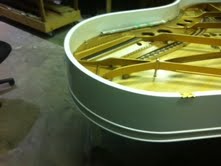
Some more reasons to rebuild:
1) The basic construction of many older pianos like Steinway & Sons is so good that a new piano, even of the same make, is usually less well built. Many manufacturers of new pianos are using inferior materials and workmanship.
2) Technology is available now to make your piano better than it was even when it was new. By having your old piano restored by us you can be sure that your piano will have premium attention given to every aspect of the action regulation. As a matter of fact, you could be involved in the process.
3) When having your old piano restored you can specify the exact colour of finish you want and even if your original ivories look so horrid you think they can't be saved, they can probably be made to look splendid again. No need to settle for what you can find on the showroom floor at the piano store.
If you decide to restore your piano and you want us to do it, we will need to sit down and discuss the extensiveness of the process. We will try to clearly explain what we think should be done and why. Please email or call us at 0917.895.0011.
Pianos age very gradually. Often the piano owner doesn't notice the slow decline in their piano because it has happened so slowly. I find generally speaking, that by the time a piano reaches the thirty year mark the hammers are losing their ability to be voiced properly. The bass strings may be starting to noticeably decline as well. Often replacing the bass strings (or all of the strings) and installing new hammers will make these pianos sing like new once again.
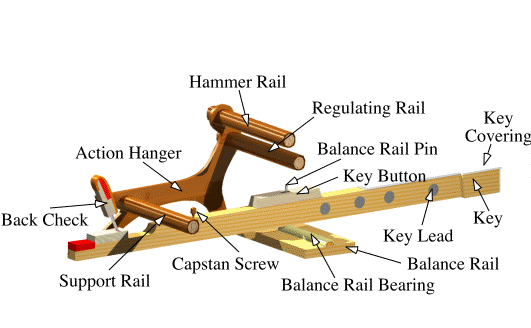
A piano that has been played frequently over the years may also require some action restoration by this point. This will depend on the demands of the pianist and their expectations. Many pianos don't have this kind of restoration done until they are much older and the decline in the instrument is so noticeable that it can no longer be ignored. At this point the real question will be "is it worth it"? A thorough inspection by a qualified technician will be required to answer this question.
Rebuilding does not mean refinishing although refinishing may be included as a part of a rebuild. Real rebuilding involves restoring the musical instrument to like new condition. Typically this will mean replacing the strings, hammers, hammer shanks, damper felt, key bushings and keybed felt as well as shimming the soundboard cracks and recapping cracked bridges. A complete rebuild could also involve replacing the pinblock and the soundboard. So what does all this mean? Back to front page.
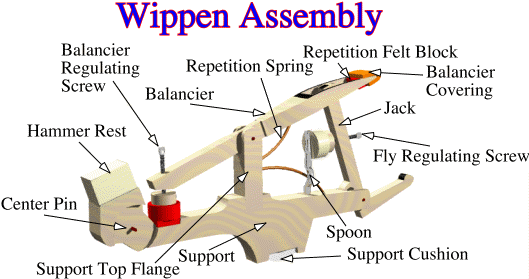
Restringing
This is pretty straight forward. The old strings oxidize and loose their original elasticity, the tone suffers and the instrument becomes very difficult to tune. The bass strings in particular get "thumpy sounding" and the notes die quickly upon being sounded. Replacing the strings restores the clarity and sustaining qualities to that of a new piano. The tuning pins are also replaced with larger new pins during this procedure to ensure tight pins that will hold a proper tuning for years to come.
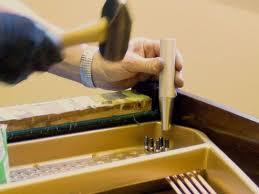
New Hammers
Unlike a violin, a harp or a guitar, the musicians hands never touch the strings of a piano. The hammers are like the musicians fingers on the strings. It is only through the hammers that the pianist can express themselves through the strings of the instrument. The hammers create the tone. This is why replacing old hammers can have such a dramatic effect on piano tone. An extreme example of this is a "honky tonk" piano where the hammers are so worn out that it sounds like a completely different instrument.
New Hammer Shanks
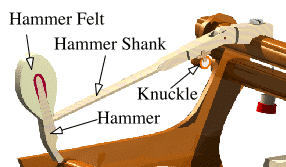
It has become increasingly common to replace the hammer shanks when restoring a grand piano. This component of the action is where the pianist will feel the ability to control their touch. The flip side of this of course is a piano where the action centers for the hammer shanks are worn out. When this happens the pianist will not be able to control how hard they strike the strings. If often sounds like they are banging on the piano even though they are trying to play softly. New shanks will restore the solid feel of a new piano to the action.
Damper Felt
Older pianos often have notes that don't stop cleanly after the note is played. Many of these pianos have a slightly "haunted" sound as the notes reverberate after the key has been played. New damper felt restores the dampers ability to stop notes cleanly.
Soundboard Shimming and Bridge Recapping
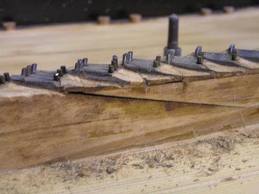
The time to repair soundboard cracks and repair a cracked bridge is when the strings have been removed for restringing. This is the only time that a piano technician has free access to these components. It would also be a mistake to install new strings over cracked bridges and a cracked soundboard as it will affect the tone adversely for years to come.
Pinblock Replacement
Many older pianos have arrived at the point where replacing the tuning pins with larger pins will not result in tuning pins that are tight enough to hold the strings at pitch. When this happens the only real solution is to replace the pinblock. This procedure is more much more common with grand pianos than upright pianos. This is because the pinblock in an upright is under less stress being glued directly to the back of the piano. A grand piano is also more likely to be worth the cost of this repair.This is a job for an experienced technician.
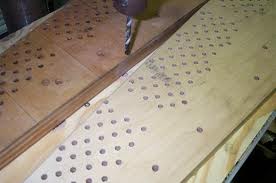 When a new pinblock is installed it must be fitted exactly to the piano's iron plate. Any gaps that are left between the pinblock and the plate will result in a piano that will never stay in tune properly. This procedure can only be done by very experienced technicians that have done it hundreds or times!
When a new pinblock is installed it must be fitted exactly to the piano's iron plate. Any gaps that are left between the pinblock and the plate will result in a piano that will never stay in tune properly. This procedure can only be done by very experienced technicians that have done it hundreds or times!
The quality of the wood is of utmost importance because if not the right quality, the pins will lose torck almost immediately and within 1-2 years the piano will need tuning every month.
Soundboard Replacement
Once only preformed in rare cases, this procedure is becoming more common place. It is still primarily reserved for very valuable pianos. Once an instument has a new sound board, we can then truly speak of a piano that is totally remanufactured.
We offer complete a piano rebuilding service. This includes pinblock replacement as well as bridge, soundboard repairs and action restoration. Many older grand pianos can be made to perform and sound like new. This may be of particular interest to people who own high quality older North American built pianos. Many people prefer the sound of these instruments because of the quality of the sound produced by these classic grand pianos.
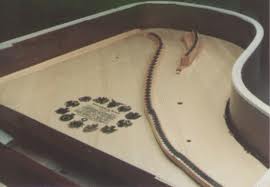
A number of the Asian pianos sold are of very high quality but they have a characteristic sound that is not to every one's liking. In the same way that not everyone likes the same music, not everyone likes the same sound qualities in pianos.
Unfortunately with the exception of a handful of pianos makes such as Steinway, Mason & Hamlin, Baldwin and Chickering all of the other North American manufacturers of high quality grands have gone out of business. Fortunately there are many of these instruments that can be acquired and with the proper restoration, can be made to sing again. This does not mean that we would necessarily recommend rebuilt pianos over new but depending on their quality and condition, they may represent a viable alternative.
The original quality of materials, design and workmanship ensure a good result assuming that the restoration is performed by a qualified technician. We have all the experience to rebuild, to perfection, the piano presented to us, no matter what shape it is in, even cracked sound boards we can fix.
NEW SOUNDBOARDS ARE NOT THE WAY TO GO, THEY CHANGE THE ENTiRE CHARACTER OF THE PIANO.
If your technician tells you they have to instal a new soundboard, he basically tells you he cannot repair the old one!!. Also, cracks should be fixed in such a way that you will almost not be able to see them! The picture you see above is a Steinway Grand Piano we fixed with 16 cracks! And remember: If the technician cannot set the bearing right, you will never get good sound out of the piano, no matter how good the rest is, it's like having a new car with a plugged carburator! Back to front page.